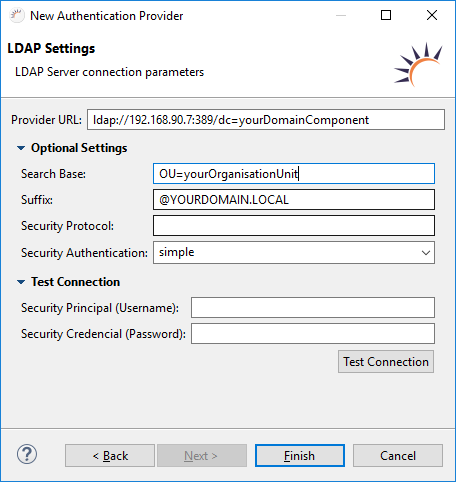Specify the URL of your LDAP server in Provider URL.
Enter the relevant parameters for your LDAP server in Optional Settings.
Click Finish.
Options:
- Optional Settings
- Search Base - Defines where in the directory the LDAP search starts.
- CN - commonName.
- L - localityName.
- ST - stateOrProvinceName.
- O - organizationName.
- OU - organizationalUnitName.
- C - countryName.
- STREET - streetAddress.
- DC - domainComponent.
- UID - userid.
- Suffix - Root, data object at the top of the LDAP data structure.
- Security Protocol - Optional Protocol Security (e.g. SASL, SSL)
- Security Authentication - Standard Security Protocol (none / simple / SASL)
- Search Base - Defines where in the directory the LDAP search starts.
- Test Connection - Personal username and password. Required only to test the connection.
Result:
Project Management > Business Objects - The ExampleAuthenticationProvider.java class is generated.
package com.company.example.business; import javax.naming.directory.DirContext; import com.xdev.security.authentication.Authenticator; import com.xdev.security.authentication.AuthenticatorProvider; import com.xdev.security.authentication.CredentialsUsernamePassword; import com.xdev.security.authentication.ldap.LDAPAuthenticator; import com.xdev.security.authentication.ldap.LDAPConfiguration.LDAPConfigurationBuilder; public class MyAuthenticationProvider implements AuthenticatorProvider<CredentialsUsernamePassword, DirContext> { private static MyAuthenticationProvider INSTANCE; public static MyAuthenticationProvider getInstance() { if (INSTANCE == null) { INSTANCE = new MyAuthenticationProvider(); } return INSTANCE; } private LDAPAuthenticator authenticator; private MyAuthenticationProvider() { } @Override public Authenticator<CredentialsUsernamePassword, DirContext> provideAuthenticator() { if (this.authenticator == null) { this.authenticator = new LDAPAuthenticator( new LDAPConfigurationBuilder("ldap://192.168.90.7:389/dc=yourDomainComponent,dc=local") .searchBase("OU=SBSUsers,OU=Users,OU=MyBusiness").suffix("@YOURDOMAIN.LOCAL") .securityAuthentication("simple").build()); } return this.authenticator; } }
